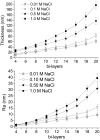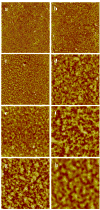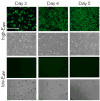Tuning the mechanical properties of bioreducible multilayer films for improved cell adhesion and transfection activity
- PMID: 20580430
- PMCID: PMC2904610
- DOI: 10.1016/j.biomaterials.2010.06.002
Tuning the mechanical properties of bioreducible multilayer films for improved cell adhesion and transfection activity
Abstract
A simple approach to the mechanical modulation of layer-by-layer (LbL) films is through manipulation of the film assembly. Here, we report results based on altering the salt concentration during film assembly and its effect on film rigidity. Based on changes in film rigidity, cell adhesion characteristics and transfection activity were investigated in vitro. LbL films consisting of reducible hyperbranched poly(amide amine) (RHB) have been implemented along with DNA for investigating fibroblast adhesion on [RHB/DNA](n/2) films with varying rigidities. The rigidity was varied by changing the ionic concentration of the deposition solution between 0.01 m NaCl and 1.0 m NaCl. Molecular force probe (MFP) measurements were performed to measure the apparent Young's modulus, E(APP), of the films in situ. Cell adhesion and stress-fiber characteristics were investigated using total internal reflectance microscopy (TIRF-M). The average cell peripheral area, fiber density and average fiber length during 5 days of cell growth on films with either low (below 2.0 MPa) or high (above 2.0 MPa) film elastic modulus were investigated. Transfection studies were performed using gfpDNA and SEAP-DNA to investigate if changes in cell adhesion affect transfection activity. Furthermore, cell proliferation and cytotoxicity studies were used to investigate cellular viability over a week. The results have shown that surface modification of bioreducible LbL films of controlled thickness and roughness promotes cellular adhesion, stress-fiber growth and increased transfection activity without the need for an additional adhesive protein pre-coating of the surface or chemical cross-linking of the film.
Copyright (c) 2010 Elsevier Ltd. All rights reserved.
Figures






Similar articles
-
Cross-linked bioreducible layer-by-layer films for increased cell adhesion and transgene expression.J Phys Chem B. 2010 Apr 29;114(16):5283-91. doi: 10.1021/jp100486h. J Phys Chem B. 2010. PMID: 20369813 Free PMC article.
-
Layer-by-layer DNA films incorporating highly transfecting bioreducible poly(amido amine) and polyethylenimine for sequential gene delivery.Int J Nanomedicine. 2018 Aug 31;13:4943-4960. doi: 10.2147/IJN.S162353. eCollection 2018. Int J Nanomedicine. 2018. PMID: 30214199 Free PMC article.
-
Gene delivery in vitro and in vivo from bioreducible multilayered polyelectrolyte films of plasmid DNA.Biomaterials. 2009 Feb;30(5):939-50. doi: 10.1016/j.biomaterials.2008.10.012. Epub 2008 Nov 17. Biomaterials. 2009. PMID: 19013638 Free PMC article.
-
Dendrimer-grafted bioreducible polycation/DNA multilayered films with low cytotoxicity and high transfection ability.Mater Sci Eng C Mater Biol Appl. 2019 May;98:737-745. doi: 10.1016/j.msec.2018.12.111. Epub 2019 Jan 2. Mater Sci Eng C Mater Biol Appl. 2019. PMID: 30813078
-
Elasticity, biodegradability and cell adhesive properties of chitosan/hyaluronan multilayer films.Biomed Mater. 2007 Mar;2(1):S45-51. doi: 10.1088/1748-6041/2/1/S07. Epub 2007 Mar 2. Biomed Mater. 2007. PMID: 18458419
Cited by
-
Nanocomposite plasters for the treatment of superficial tumors by chemo-photothermal combination therapy.Int J Nanomedicine. 2018 Oct 9;13:6235-6247. doi: 10.2147/IJN.S170209. eCollection 2018. Int J Nanomedicine. 2018. PMID: 30349247 Free PMC article.
-
High-throughput screening of microscale pitted substrate topographies for enhanced nonviral transfection efficiency in primary human fibroblasts.Biomaterials. 2011 May;32(14):3611-9. doi: 10.1016/j.biomaterials.2011.01.040. Epub 2011 Feb 21. Biomaterials. 2011. PMID: 21334062 Free PMC article.
-
Cartilage oligomeric matrix protein gene multilayers inhibit osteogenic differentiation and promote chondrogenic differentiation of mesenchymal stem cells.Int J Mol Sci. 2014 Nov 5;15(11):20117-33. doi: 10.3390/ijms151120117. Int J Mol Sci. 2014. PMID: 25380520 Free PMC article.
-
Bioreducible polycations in nucleic acid delivery: past, present, and future trends.Macromol Biosci. 2014 Jul;14(7):908-22. doi: 10.1002/mabi.201400061. Epub 2014 Mar 28. Macromol Biosci. 2014. PMID: 24678057 Free PMC article. Review.
-
The toxicity of nanoparticles and their interaction with cells: an in vitro metabolomic perspective.Nanoscale Adv. 2023 Jan 30;5(10):2674-2723. doi: 10.1039/d2na00534d. eCollection 2023 May 16. Nanoscale Adv. 2023. PMID: 37205285 Free PMC article. Review.
References
-
- Healy KE. Molecular engineering of materials for bioreactivity. Curr Opin Solid State Mater Sci. 1999;4:381–87.
-
- Dillow AK, Tirrell M. Targeted cellular adhesion at biomaterial interfaces. Curr Opin Solid State Maters Sci. 1998;3:252–59.
-
- Discher DE, Janmey P, Wang YL. Tissue cells feel and respond to the stiffness of their substrate. Science. 2005;310:1139–43. - PubMed
-
- Bershadsky AD, Balaban NQ, Geiger B. Adhesion-dependent cell mechanosensitivity. Annu Rev Cell Dev Biol. 2003;9:677–95. - PubMed
Publication types
MeSH terms
Substances
Grants and funding
LinkOut - more resources
Full Text Sources

